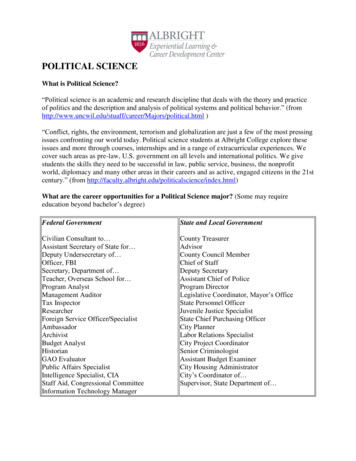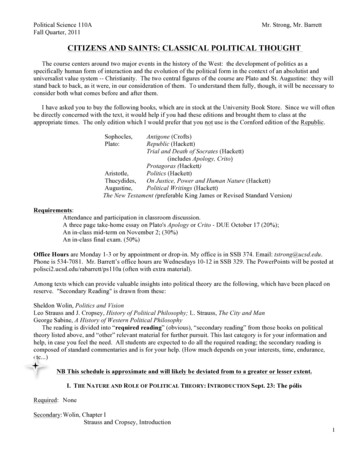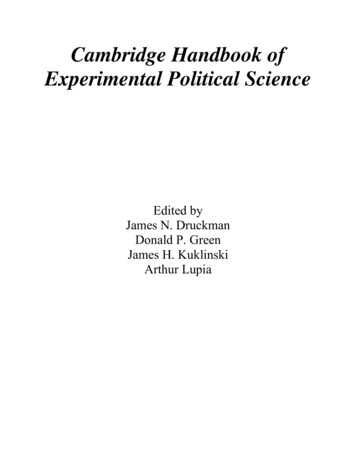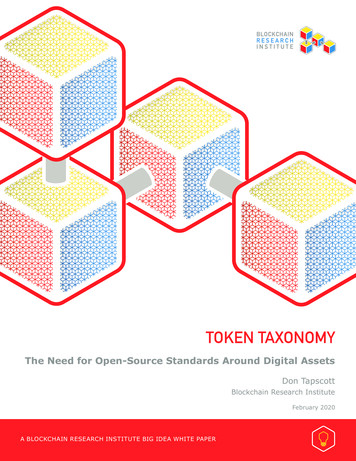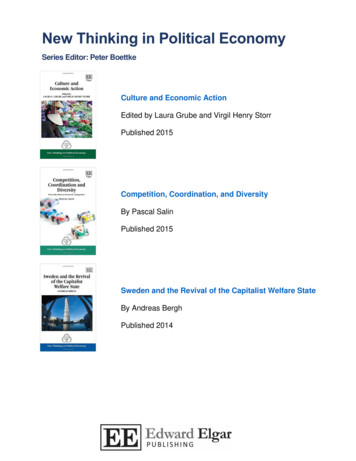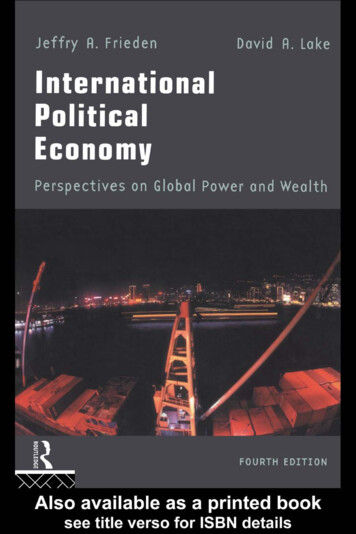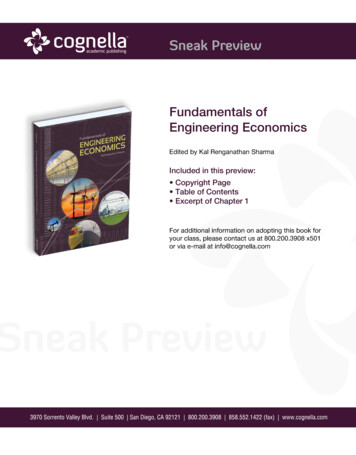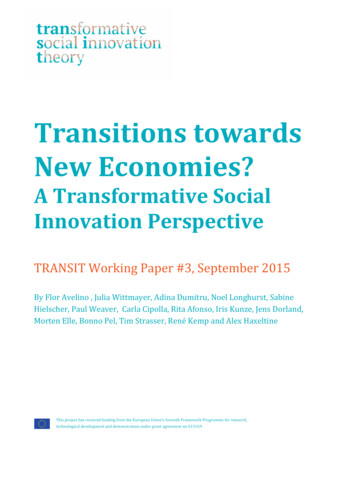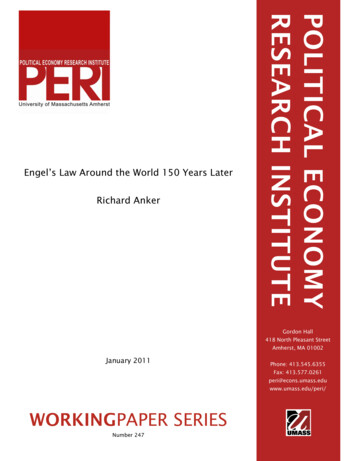
Transcription
Richard AnkerPOLITICAL ECONOMYRESEARCH INSTITUTEEngel’s Law Around the World 150 Years LaterGordon Hall418 North Pleasant StreetAmherst, MA 01002January 2011Phone: 413.545.6355Fax: /WORKINGPAPER SERIESNumber 247
Engel’s law around the world 150 years laterAcknowledgementsI would like to thank Guy Standing, Joe Ritter and James Heinz for their valuable commentsand suggestions and Valentina Stoevska for help in providing data and clarifying concepts.As usual though, my wife Martha deserves the greatest thanks for her suggestions, input andhelp.1.0 IntroductionOne of the most enduring relationships in economics is that proposed by Ernst Engel in 1857.Even today, it is often referred to as a law, “Engel’s law”.“The poorer is a family, the greater is the proportion of the total outgo [family expenditures] which must be used for food. The proportion of the outgo used for food,other things being equal is the best measure of the material standard of living of apopulation.” (Engel quoted in Zimmerman, 1932)The 150th anniversary of Engel’s law passed in 2007. With this in mind, the present paperlooks at the extent to which Engel’s law is relevant in today’s world by looking across countries at the relationship between the share of household expenditure spent on food and national income per capita.Investigating the relevance of Engel’s law is not just of historical interest. Poverty reductionis arguably the most important objective of the United Nations’ Millennium DevelopmentGoals as well as of national policy in many countries - - and the food share of household expenditure is often used to measure national poverty lines and therefore help determine national poverty rates. 1 It is also possible to argue that the 2008 financial crisis, which wascaused by a bubble in American house prices, was inevitable because the proportion of expenditure for a major item such as housing, or food, is not sustainable when it far exceedshistoric norms (Shiller, 2008; Interest.com).This paper provides an empirical analysis of Engel’s aw based on data for almost every country and territory in the world. The paper is structured as follows. Section 2 reviews how theview of Engel’s law has evolved over the past 150 years. Section 3 describes the data used inthe cross-national empirical analysis. It begins with a description of how data on the foodshare of household expenditure was collected. This includes discussion of the internationalstandard classification for household expenditure; sources used to find national estimates;and aspects which reduce cross-country comparability of national food share estimates (de1The most common methodology to calculate a national poverty line is to divide the cost of a nutritionally acceptablediet by the food share of household expenditures. A wide range of countries use this approach to estimate their nationalpoverty line including United States (Orshansky, 1969); Philippines, Thailand, and Vietnam in Asia (Asra and SantosFrancisco, 2001); and many Latin American countries (Sainz, 1994).1
pendant variable in cross-national analysis) and income per capita in purchasing power parityunits (main explanatory variable in cross-national analysis). Section 4 is concerned with analytical issues. Section 5 begins the empirical analysis with an analysis of household incomeand expenditure survey data tabulated by income decile for 46 countries or territories to observe if Engel’s law still operates today at the household level within countries. The crossnational analysis of national level data in Section 6 begins with scatterplots and descriptivestatistics, and goes on to a multivariate regression analysis. Section 7 provides conclusions.Appendix A investigates the relationship between food share and expenditure for food takenaway from home, since the latter should reduce the former.A feature of this paper is that it is based on data for almost all countries and territories in theworld (207), many more than in previous studies have used. This facilitates analysis of therelationship between the food share of household expenditure and national income per capita,especially how this differs by development level. Other distinguishing features of this papercompared to previous cross-national studies are that: national food share estimates are fromnational statistical offices based almost exclusively on household budget surveys and not estimates from international organizations or SNA statistics; expenditures for alcohol, tobaccoand food taken away from home are excluded from reported food expenditure whenever anational statistical office included these in food expenditure; income per capita in PPP andfood expenditure are measured for the same year; and newly revised and improved WorldBank estimates of GDP per capita in PPP are used to measure national material standard ofliving. In contrast, previous cross-national studies have often: used food expenditure as reported by national authorities or international organizations even though alcohol, tobacco andfood taken away from home are often included in reported food expenditure; used food shareestimates based on SNA statistics that include all expenditure by individuals in a country regardless of whether they are by tourists, cross-border persons or residents; been based on datafor different years for food share and per capita income, because countries always use datafrom an earlier year to estimate food share and often a much earlier year; and did not haveaccess to the newly revised and improved World Bank estimates of GDP per capita in PPP.It was possible to find data on the food share of household expenditure for virtually everycountry and territory in the world, because household expenditure weights (including ofcourse percent for food) are required to calculate CPI (consumer price index) and CPI is anessential tool of economic and policy. It is highly unusual to have an economic variable withnational values for almost every country and territory in the world estimated by national statistical offices. This has important advantages, because national statistical offices understandlocal conditions and base expenditure share estimates on local data. Much more typical whennational values are available for an economic variable for almost all countries and territoriesin the world is for these values to have been estimated by an international organization suchas UN, ILO or World Bank. The disadvantage of using estimates from national offices is thatthis reduces cross-national comparability, because national statistical offices use differentmethodologies and definitions. For this reason, considerable effort was put into improvingcross-country comparability of national food share data as well as to take into considerationin the cross-national analysis differences in national practices as regards measurement offood share.2
2.0 Historical background of Engel’s lawIn 1857, Ernst Engel argued that there is a relationship between food expenditure and incomeusing data for 36 European households provided by Le Play and 199 Belgium householdsprovided by Ducpetiaux. As Engels put it, “They delivered the pearls but not the string”(Engel 1857 quoted in Perthel 1975). Engel found an extremely consistent relationship acrosshouseholds between the food share of household expenditure and household income. Perthel(1975) was able to obtain an R2 of .9998 for the LePlay data set, and an R2 of .76 for all 235households (with an R2 of .998 when data were aggregated into seven groups). Income elasticity of food expenditure was .86 for each data set. Although Engel probably massaged hisdata sets to obtain a more regular relationship between food expenditure and income than existed in the original data (Perthel, 1975), as such fits do not occur in micro household data(e.g. food share of household expenditure increases with income across all 29 households inthe Le Play data), Engel’s law took hold in economics.By 1875, Engel’s law had passed over the Atlantic, receiving confirmation and anointment.Wright (1875) waxed “The remarkable harmony in the items of expenditure [between Massachusetts, and Europe] shown by percentage of total expenditure must establish the soundnessof the economic law pronounced by Dr. Engel.” As head of the Massachusetts Bureau of Labor Statistics (and later first commissioner of the Bureau of Labor Statistics for the UnitedStates), Wright was not content to stop at food expenditure like Engel, and stated that thepercentage of household expenditure for clothing (constant), housing (constant), and sundries(increased) also varied with income in accordance with Engel’s law. There was no place forambivalence as regards Engel’s law or laws at this point in time.On the 75th anniversary of Engel’s law, a review article by Zimmerman (1932) indicates thatEngel’s law continued to retain its importance as this article begins by saying: “In the field offamily consumption and expenditures, one theory attracts first attention above all others – theso-called Engel’s law.” There is, however, now considerable skepticism about the reach anduniversality of Engel’s law. Zimmerman hammers home the point that Engel was only concerned with the relationship between food expenditure and income (being greatly influencedby the idea of arithmetic and geometric progressions of Malthus, with food expenditure increasing at an arithmetic rate and sundry expenditures at a geometric rate), and that others hadinappropriately attributed to Engel additional laws on the relationship of non-food items toincome. Zimmerman also discusses at length why Engel’s law is not universal across allhousehold, countries, and time periods and concludes that: “It is evident that Engel’s law, rigidly interpreted [i.e. food share falls with increased household income], is not true for particular families, for particular times, and under certain circumstances,” and that “The ‘Engel’ typeof standard of living [i.e. food share of household expenditures] applies to no more than halfof the people of the globe.” 2 To explain exceptions to Engel’s law, Zimmerman mentions differences in personal tastes, cultural preferences, family size, and changes in the types of foodpurchased. By 1932 then, Engel’s law was still considered very important both as a relation-2At the same time, Zimmerman (1932) also concluded that the amount of food expenditures always increases with anincrease in income: “The studies made so far indicate that food expenditures nearly always increase with increasedexpenditure. I know of no exceptions to this rule. It is one of the elementary and important laws of living.”3
ship and as an essential measure of welfare. At the same time, it was being questioned basedin large part on household budget survey data that were just then becoming widely available. 3On the centenary of Engel’s law in 1957, a review article by Houthakker (1957) continued toindicate that Engel’s law occupied a central place in economics. The first few sentences read:“Few dates in the history of econometrics are more significant than 1857. In that year, ErnstEngel (1821-1896) published a study in which he formulated an empirical law concerning therelationship between income and expenditure on food. Engel’s law, as it has since becomeknown, states that the proportion of income spent on food declines as income increase.” Discussion in 1957 has now shifted to empirical analysis and statistical confirmation.4 Alsochanged from 25 years earlier is any discussion that Engel’s law relates to only food expenditure, a point emphasized in Zimmerman’s 1932 review. Engel’s law is now considered to bea series of laws. Houthakker (1957) devotes most of his review article to estimating household income elasticities for food, clothing, housing, and miscellaneous items using data fromapproximately 40 household surveys and 30 countries. Because it is now accepted thathousehold income or expenditure is not the only determinant of the food share of householdexpenditures, Houthakker controls for family size in regressions as well as points out that hisresults may have been affected by other factors that were not controled for such as relativeprices. He finds that “The elasticities are found to be similar but not equal [across surveys].Engel’s law, formulated in 1857, is confirmed by all surveys. To return to the problem ofdevelopment planning: If no data on the expenditure patterns of a country are available at all,one would not be very far astray by putting the partial elasticity at 0.6 with respect to food.”Since 1957, analyses of food expenditure patterns have become mainly empirical using increasingly sophisticated statistical models, in part made possible by an explosion in the availability of household budget data around the world. It is now common for empirical studies ofhousehold expenditures to simultaneously analyze how different types of expenditures varyalong with household income or total expenditure (unlike Houthakker who analyzed eachtype of expenditure separately in 1957). Empirical analysis of household expenditures nowroutinely control for non-income factors that affect the food share of household expendituressuch as prices and family size. And it is now conventional wisdom that the income elasticityof food expenditure is less than 1.0 and therefore the food share of household expenditurefalls with income. Perhaps for this reason, Engel’s law is now mainly referred to as an historical curiosity in the introduction section of papers.Recent work on household expenditure patterns has been based almost always on householddata. There have been relatively few cross-national studies of the extent to which Engel’s lawremains relevant across countries in the 21st century. A notable exception is a study by Sealeand Regmi (2006) that simultaneously estimated parameters for nine expenditure groups withfood as one of these groups. They found that the income elasticity of food expenditure fellfrom about .7 for low income countries to .6, .5 and .1 to .3 for lower middle income, uppermiddle income and high income countries respectively. This study differs from the present3ILO’s International Labor Review, for example, published between 1929 and 1936 many articles based on familybudget enquiries because of an increasing interest in the welfare and standard of living of workers around the world.This included, among others, articles on Belgium, Ceylon, China, Denmark, England, Finland, Germany, India, Japan,Malaysia, South Africa, Russia, Sweden, and United States.4Houthakker was himself a major player in this empirical analysis, as the Prais and Houthakker (1955) detailed analysis of British household expenditure data is a classic in this field.4
study is several ways. They used data for 114 countries whereas the present study uses datafor 207 countries. They dropped 23 countries from their analysis based on regression residuals, whereas this is not done in the present study. They included alcohol and tobacco expenditure in food expenditure because these were included in the ICP food expenditure data theyused, whereas the present study excludes alcohol and tobacco expenditure. Their expenditureestimates are often based on SNA statistics and so based on all expenditure on a territory andnot just on expenditure of resident households whereas the food expenditure estimates usedin the present study are almost always based on household budget survey data. They did notexplicitly consider, in contrast to the present study, frequent difference between year of CPIexpenditure weight estimates and data year of expenditure data on which they are based; orwhether data were national or for urban areas only; or whether food expenditure included expenditure for food away from home; or take into consideration distribution of household income; or if a country is a transition economy. They did, however, use more sophisticatedstatistical estimation models than the present study and included prices as an explanatoryvariable whereas the present study does not.This paper, then, investigates the following questions related to Engel’s law. Does the foodshare of household expenditure in countries decrease as national per capita income increases;if so does this occur at all development levels and in all parts of the world? And is the foodshare of household expenditure a good measure of the material standard of living of countriesin the 21st century in all parts of the world and at all development levels?3.0 DataThis section describes data used in the cross-national empirical analysis in Section 6. It begins with a description of how national food share of household expenditure estimates weregathered and aspects of these data that might affect cross-national comparability. It goes onto describe how income per capita in PPP and other explanatory variables are measured andhow measurement of PPP might affect the cross-national empirical results in Section 6.3.1 Recent national estimates of food share of household expenditureData for 207 countries or territories on the food share of household expenditure are used inthe cross-national analysis in this paper to observe if Engel’s law is relevant today acrosscountries along with economic development and increasing per capita income. Also, datafrom 46 national household income and expenditure surveys tabulated by income decile areused to confirm that Engel’s law is still relevant today at the household level within countries.Data on food share of household expenditure are available for virtually every country andterritory in the world, because tracking inflation is universally considered an essential tool ofeconomic and monetary policy, and household expenditure weights for a fixed basket ofgoods and services are required to calculate CPI (with food one of the main components inthis basket). 5 Availability of data for almost every country and territory is a great advantage5Inflation is calculated by dividing the average price of a fixed basket of goods and services (i.e. fixed set of expenditure weights or shares) in period t 1 by the average price for this basket in period t.5
for investigating whether the relationship between the food share of household expenditureand national income per capita differs by development level.National estimates of the food share of household expenditure were almost exclusively drawnfrom official government statistics used to calculate CPI. I started with large ILO and IMFdata bases, which included information on household expenditure weights countries and territories used to calculate national CPI. 6 I was given access to country files kept in ILO’s Geneva headquarters that contain national information and publications on CPI expenditureweights sent to ILO over the past couple of decades in response to an annual ILO request forsuch information. There was also an ILO (2007) online metadata with national CPI statisticsand information including expenditure weights for 177 countries and territories, although theusefulness of this ILO metadata is limited because it is somewhat out-of-date as it is based oninformation from an ILO (1992) publication supplemented by an ILO (1999) publication fortransition economy countries. There was also an online IMF (2007) online metadata of CPIstatistics and information for 75 countries and territories that often included national expenditure weights used to estimate CPI.National food share estimates from these three ILO and IMF databases were supplementedprimarily by searching national statistical office web sites using a list of web site links provided by ILO. National statistical web sites of well over 100 countries and territories weresearched - - whenever recent food expenditure weights were not available in any of the threeILO or IMF databases, or estimates from these three databases were inconsistent or problematic in some way. Finally, miscellaneous sources were used for 10 countries or territories forwhich I still did not have a recent estimate of the food share of household expenditure. 7 Alltogether, an estimate of food share of household expenditure was found for 207 of the 229countries and territories in the world and 99 percent of the world’s population. 8In the process of putting together the data set on food shares, I often ended up with estimatesfor different years and/or multiple estimates for one year for countries and territories. 9 Whenthis happened, the following rules were used to choose a national estimate. First, the most6ILO and IMF are the two international organizations especially concerned with and responsible for CPI statistics. ILOhas a mandate from the international statistical community for CPI statistics, sets international statistical standards onhow to measure CPI, publishes manuals on CPI measurement, provides technical assistance to countries interested inimproving CPI statistics, and requests countries to send it information on CPI (including information on expenditureweights). IMF has an interest in price stability and encourages and assists developing and transition economy countriesto improve CPI statistics. Both organizations regularly report and publish national CPI estimates.7Miscellaneous sources were regional organization databases for 7 countries or territories (2 from AFRISTAT (2001),3 from OECD (2007), 2 from European Central Bank (Herrmann and Polgar, 2007), 2 from ICP, International Comparability Program (World Bank, 2008a), and 1 from an ILO (2007) online database of national household income andexpenditure surveys.8I did not find an estimate of the food share of household expenditures for the following: Cuba, Dominican Republic,Eritrea, Guernsey, Holy See, Korea Democratic Republic, Lichtenstein, Libya, Micronesia, Monaco, Nauru, NorthernMarianas, Palau, Tokelau, Turkmenistan, Turks and Caicos, Uzbekistan, and Western Sahara. There were also fourcountries or territories for whom I found an estimate from ILO (1992) that I did not use, because this estimate was either based on an unrepresentative sample (low income households in Vanuatu) or felt to be too old (Liberia 1963-64;Guyana, 1969-70; Falkland Islands, 1971).9For example, I found the following regional databases of national CPI expenditure weights: (i) EUROSTAT (2008)harmonized database for 30 countries; (ii) OECD (2007) metadata for 32 countries; (iii) MERCOSUR and Chile harmonized data for 5 South American countries (IBGE, 2007); (iv) AFRISTAT (2001) harmonized database for 10 WestAfrican countries; (v) European Central Bank data for 9 South-East European countries (Herrmann and Polgar, 2007);and (vi) ICP database for 120 countries (World Bank, 2008a).6
recent estimate from a national statistical office web site was used when available, partly because it is in the public domain and partly because detailed information was often availableindicating if expenditure for alcohol, tobacco and food taken away from home were includedin food expenditure (which allowed me to improve cross-national comparability). Next, themost recent estimate in the ILO or IMF databases and files were used when an estimate froma national statistical office web site was not available, because these databases contain official national estimates; in addition, they frequently included information on whether expenditure for alcohol, tobacco and food taken away from home were included in food expenditure.Lastly for remaining countries and territories without an estimate from a national web site orILO and IMF databases, a recent estimate from a regional organization was used. 10Table 1 indicates data sources for food share of household expenditure used in this paper.Forty three percent are from a national statistical office web site, 28 percent are from ILOcountry files containing information received from national authorities, and 24 percent arefrom IMF or ILO online metadata.Table 1. Data sources for national estimates of food share of household expenditureData sourceNumber (%) of countries orterritoriesNational statistical office web site90 (43.4%)ILO paper files in Geneva HQ with CPI reports and58 (28.0%)data sent by countries to ILO (updated annually)IMF metadata of national CPI statistics35 (16.9%)ILO metadata of national CPI statistics (mostly from14 (6.8%)early 1990s or before)Miscellaneous a10 (4.8%)Notes: a Miscellaneous sources were: AFRISTAT database (2), OECD database (3), ECB publication (2), ICP database(2), and ILO online website (1).Sources: Author’s data for sources of national estimates used in this paper. ILO (1992 and 1999) for ILO metadata andIMF (2007) for IMF metadata. Miscellaneous sources were: AFRISTSAT (2001), OECD (2007), Herrmann and Polgar(2007) for ECB, World Bank (2008a) for ICP, and ILO (2007).3.2 Comparability across countries in measurement of food share of household expendituresThis section discusses differences across countries in how the food share of household expenditures is measured and why this might affect cross-national comparability and thereforethe cross-national empirical analysis in Section 6. It is worth noting that regression analysisin Section 6 takes most of these into consideration whereas previous cross-national analyseshave not.10Food share estimates from regional organizations or international organizations were not given priority, because theirestimates were often adjusted in unknown ways as well as often based on SNA statistics and not on household budgetsurvey data.7
3.2.1 Some countries estimate CPI expenditure weights using urban data onlyAlthough a majority of countries and territories in the data set based CPI expenditure weightson data for the entire country or territory, 36 percent based expenditure weights on data forurban areas with a majority of these for the capital city only (Table 2). Estimating expenditure weights for urban areas is less common in Developed and European countries and territories (12 percent) and Transition Economy countries (21 percent). It is especially common touse urban data in developing countries: Sub-Sahara Africa (62 percent), Middle East andNorth Africa (45 percent), Latin America (44 percent), and Pacific Islands (40 percent).Table 2. Distribution of countries and territories according to whether urban or national data used to estimate food share of household expenditures, by regionRegionNationalUrban(1)All urbanCapital cityPercentareasonlyurban(2)(3)(2) (3)Sub-Sahara Africa17 (37.8%)9 (20.0%)19 (42.2%)62.2%(N 45)Latin America23 (53.7%)12 (29.3%)6 (14.6%)43.9%(N 41)Asia (N 25)20 (80.0%)1 (4.0%)4 (16.0%)20.0%Middle East & N.11 (55.0%)7 (35.0%)2 (10.0%)45.0%Africa (N 20)Pacific Islands9 (60.0%)2 (13.3%)4 (26.7%)40.0%(N 15)Developed & Europe 37 (88.1%)5 (11.9%)011.9%(N 42)Transition Economy 15 (78.9%)4 (21.1%)021.1%(N 19)Total (N 207)132 (63.8%) 40 (19.3%)35 (16.9%)75 (36.2%)Sources: Author’s data drawn from national sources.Cross-country comparability is reduced when some countries and territories estimate household expenditure weights based on data for urban households and others based on data for theentire country or territory, because the food share of household expenditure is lower in urbanareas than in rural areas. According to data for 11 developing countries with both nationaland urban expenditure weights, the average difference in food share estimates between urbanand national estimates was 11.5 percentage points and 20.6 percentage points between urbanand rural estimates (Table 3).8
Table 3. Difference between national, urban, and rural food shares used by national statistical office to calculate CPI, 11 developing countries with dataCountry orNationalUrbanRuralUrban –Urbanterritorynational 61.2 b-19.9-23.6Oman29.923.5 a50.3 0.7 a53.7 b-10.1-13.0aSolomon Is52.934.362.3-18.6-28.0landsTuvalu46.334.5 a61.9 b-11.8-27.4bVenezuela32.228.857.4-3.4-28.6Viet Nam42.934.945.8 b-8.0-10.9c, dAverage-11.5-20.6 c, d(unweighted)Notes: a Food expenditure weight is for capital city only. According to data for Venezuela and Mozambique (only twocountries with data for both capital city and all urban areas), capital city estimate is somewhat lower than urban estimate (by -3.2 and -3.6 percentage points respectively for these two countries).bRural estimate is calculated using percent urban together with food expenditure share estimates for national and urban reported in columns 2 and 3.cNote that regression analysis in Section 6.2 estimates difference between national and urban estimates.dDifference is somewhat overstated, because it does not take into consideration that food share estimate for four countries was for the capital city only which tends to be lower compared to other urban areas (see note a).Sources: Data from national sources available to author.There are several reasons why the food share of household expenditure should be lower inurban areas. First, income levels are higher in urban areas, and this should cause food shareto be lower in urban areas in line with Engel’s law. Second, non-food expenditure is higher inurban areas, because urban dwellers have greater non-food needs and costs such as for housing and transport which reduces the relative importance of food in household budgets in urban areas compared to rural areas.To take into account when the food share estimate for a country or territory is based on datafor urban households, two explanatory variables are specified in the regression analysis inSection 6. One variable indicates when a country’s food share was estimated for urban areas.A second indicates percentage urban for countries whose food share estimate was urbanbased to allow for the difference between national estimates and urban estimates to approachzero as percent urban
and aspects which reduce cross-country comparability of national food share estimates (de-1. The most common methodology to calculate a national poverty line is to divide the cost of a nutritionally acceptable diet by the food share of household expenditures. A wide range
